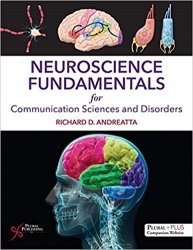Neuroscience Fundamentals for Communication Sciences and Disorders
- Добавил: harun54
- Дата: 13-05-2019, 11:34
- Комментариев: 0
 Название: Neuroscience Fundamentals for Communication Sciences and Disorders
Название: Neuroscience Fundamentals for Communication Sciences and DisordersАвтор: Richard D. Andreatta
Издательство: Plural Publishing
Год: 2018
Формат: PDF
Размер: 120 Мб
Язык: английский / English
Neuroscience Fundamentals for Communication Sciences and Disorders is a comprehensive textbook for undergraduate or graduate neuroscience courses in communication sciences and disorders programs. The goal of the textbook is to provide a thorough overview of the features, principles, processes, and structures underlying the working of the human nervous system. The textbook is designed to provide students with the neuroanatomical and physiological content relevant to CSD applications, and also content that places these features into the context of a behaving and communicative human.
Key Features:
An emphasis on fundamental information on anatomy, neurophysiological, and functional processes using a conversational writing style.
Beautifully illustrated with full-color anatomical and component figures, photographs, schematic line drawings, process flow-charts, and tables.
Three chapters on the neural bases of speech, language, and hearing help integrate the basic information from earlier chapters with findings specific to CSD.
Each chapter begins with an introduction and learning objectives and ends with review questions and a top ten summary list.
Bolded key terms throughout with a glossary of definitions for comprehension.
Clinical Importance Boxes highlight clinically relevant disorders and syndromes that compliment topic coverage.
Interesting Facts Boxes highlight interesting, fun, and quirky facts about the nervous systems structure, physiology, and functionality.
A PluralPlus companion website with PowerPoint lecture slides, instructional videos, and a sample syllabus for instructors, and interactive quizzes and flashcards for students.
Neuroscience Fundamentals for Communication Sciences and Disorders includes several chapters on broad topics related to brain and behavior relationships such as learning, skill acquisition, attention and memory, emotion, and neuroplasticity. These chapters go beyond typical neuroanatomy content to cover the large scale concepts that CSD students need to internalize to understand how humans learn, how and why we behave, and how these concepts apply to communication disorders. Such an understanding will deepen the student's appreciation of the critical relevance of CSD in life and the importance of treatment to regain effective communication after disease, injury, or as a function of disorder.
Внимание
Уважаемый посетитель, Вы зашли на сайт как незарегистрированный пользователь.
Мы рекомендуем Вам зарегистрироваться либо войти на сайт под своим именем.
Уважаемый посетитель, Вы зашли на сайт как незарегистрированный пользователь.
Мы рекомендуем Вам зарегистрироваться либо войти на сайт под своим именем.
Информация
Посетители, находящиеся в группе Гости, не могут оставлять комментарии к данной публикации.
Посетители, находящиеся в группе Гости, не могут оставлять комментарии к данной публикации.
